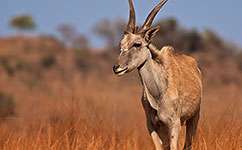Herbivores help prevent African savannah from becoming a forest

Grazing herbivores play a major role in maintaining savannah landscapes, say scientists.
NERC-funded researchers have been studying a savannah in East Africa over the past ten years to try to understand why trees are so sparse in these grassy areas.
Savannahs are grasslands that are spotted with trees, but these two types of vegetation - grass and trees - require very different light, water and nutrient levels . To co-exist, they create a landscape that's not quite a forest and not quite grassland, and scientists remain in debate about whether or not this coexistence is stable.
Until now, fires were thought to be the main factor in preventing trees from taking over the landscape and turning it into woodland. But this latest research has shown that herbivores grazing in the area may be just as important.
'Herbivores play a dual role in maintaining a savannah landscape,' says lead-author Dr Mahesh Sankaran, of the University of Leeds and the National Centre for Biological Sciences (NCBS) in Bangalore, India. 'Smaller herbivores graze on lower seedlings and saplings, preventing them from growing into larger things. While larger bodied herbivores, like elephants, knock down trees , stop them from growing as much and prevent them from dominating.'
By eating saplings before they have a chance to grow, the herbivores prevent the trees from encroaching on the landscape and turning it into a woodland.
The experiment was carried out in a controlled area, where 10 years ago scientists mapped and measured every single tree. In this area fires, which are known to harm sapling trees and maintain a savannah landscape, are suppressed . The scientists were intrigued as to what other factors could be maintaining the balance of grass and trees.
They closed off some areas to exclude animals so that after a decade, when the scientists returned, they could assess which trees had survived and what effect animals had in the areas they could reach.
The team found that without herbivores, seven times more trees grew during the ten year study period . This was the first study ever to track individual trees in an African savannah where herbivores have been excluded.
"Our results demonstrate unequivocally that herbivores have a dramatic influence in maintaining savannahs , and removing them could cause trees to rapidly take over," Sankaran says.
The work was carried out in close collaboration with researchers from the Rangeland Resources Research Unit, USDA in Colorada, USA.
More information: Sankaran, M., Augustine, D. J., Ratnam, J. (2013), Native ungulates of diverse body sizes collectively regulate long-term woody plant demography and structure of a semi-arid savanna. Journal of Ecology, 101: 1389-1399. DOI: 10.1111/1365-2745.12147
Journal information: Journal of Ecology
Provided by PlanetEarth Online
This story is republished courtesy of Planet Earth online, a free, companion website to the award-winning magazine Planet Earth published and funded by the Natural Environment Research Council (NERC).

















